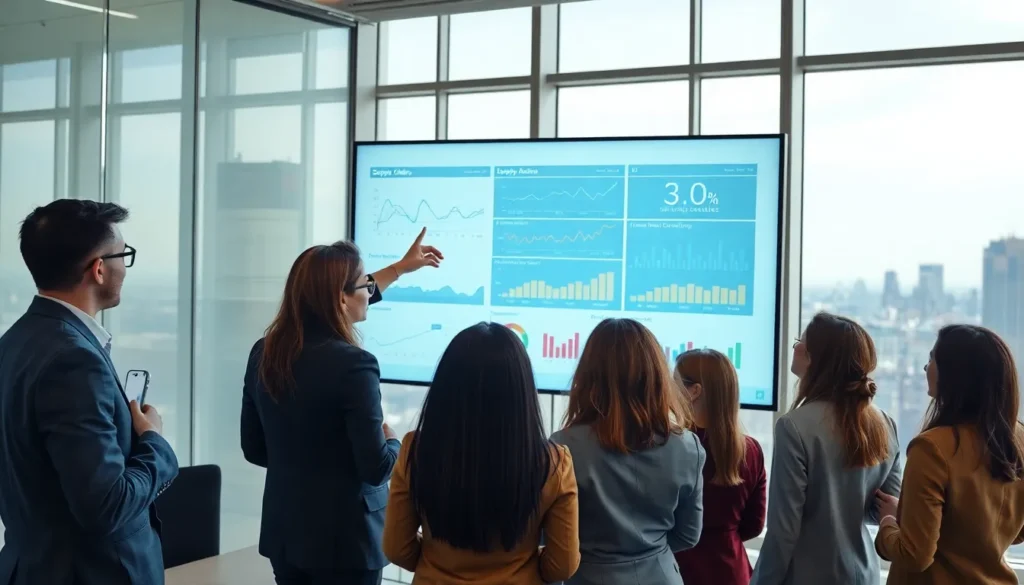As the economy wobbles like a toddler on roller skates, the question on everyone’s mind is whether a recession is lurking just around the corner. With inflation rates soaring and job markets feeling the pinch, many are left wondering if their wallets will soon feel like they’ve gone on a diet. But don’t panic just yet!
Table of Contents
ToggleUnderstanding Recession Forecasts
Recession forecasts help analyze economic trends and predict potential downturns. These predictions provide valuable insights into upcoming market conditions.
Definition of a Recession
A recession refers to a significant decline in economic activity across the economy lasting more than a few months. Specifically, it involves decreased GDP, falling employment rates, and reduced consumer spending. Economists often identify recessions by two consecutive quarters of negative GDP growth. Consequently, businesses face lower revenues, prompting cutbacks or layoffs. Understanding this definition establishes a baseline for recognizing economic struggles and their impact on society.
Importance of Recession Forecasts
Recession forecasts play a critical role in financial planning and decision-making. Businesses utilize these projections to assess risk and adjust strategies accordingly. Individuals depend on forecasts to manage personal finances and save for downturns. Policymakers rely on accurate predictions to formulate responses that stabilize the economy. Businesses with effective foresight can maintain competitiveness and ensure resilience. Overall, these forecasts serve as vital tools for navigating economic uncertainties, offering guidance to various sectors.
Key Indicators of Economic Health

Monitoring key indicators of economic health reveals insights into the likelihood of a recession. These indicators include unemployment rates, inflation trends, and GDP growth.
Unemployment Rates
High unemployment rates reflect economic distress. A significant rise in the unemployment rate often accompanies economic downturns. The U.S. Bureau of Labor Statistics reported the unemployment rate at 3.8% as of September 2023, showing a slight increase from previous months. Analysts focus on job loss patterns in various sectors to gauge economic stability. An uptick in jobless claims may indicate broader economic issues, prompting concerns about consumer spending.
Inflation Trends
Inflation rates provide critical insights into purchasing power. The Consumer Price Index revealed a 4.2% increase in inflation in August 2023. Consistently rising prices erode consumer confidence and impact spending habits. Central banks often respond to inflation spikes and adjust interest rates accordingly. Tracking core inflation, which excludes volatile items like food and energy, offers a clearer picture of underlying economic conditions.
GDP Growth
GDP growth measures overall economic performance. The U.S. economy experienced a growth rate of 2.4% in Q2 2023, illustrating modest expansion. A declining GDP over two consecutive quarters often signals a recession. Analysts monitor revisions to GDP reports for indications of changing economic forecasts. Strong consumer spending and business investment contribute positively to GDP growth, while downturns in these areas often raise recession concerns.
Current Economic Landscape
The economic landscape is marked by uncertainty, driven by a variety of factors both globally and regionally.
Global Economic Factors
Global economic conditions significantly impact national economies. Rising inflation rates in several leading economies contribute to heightened financial stress. Central banks’ aggressive interest rate hikes aim to curb inflation but may inadvertently slow growth. Trade tensions also play a role, with supply chain disruptions undermining stability. As of September 2023, several countries are grappling with high inflation, influencing consumer behavior worldwide. Analysts observe that these global fluctuations affect domestic job markets and spending patterns, which could signal potential recessions.
Regional Variations
Regional economic variations reflect diverse conditions across the U.S. Some states report robust job growth while others face stagnation. For example, the southeastern states are experiencing a tightening labor market, showing lower unemployment rates compared to others with persistently high figures. Variations in housing markets also impact regional economic health, with areas like California witnessing soaring prices while Midwestern states face affordability challenges. These disparities influence consumer spending differently, creating unique economic landscapes across the nation. Monitoring these regional indicators provides deeper insights into the U.S. economic outlook and trends that could indicate a recession.
Expert Predictions and Analysis
Economic experts offer insights into the likelihood and timing of a recession. They analyze key indicators and provide forecasts to help the public navigate uncertainty.
Leading Economists’ Views
Leading economists emphasize the significance of persistent inflation as a key concern for the economy. Specifically, many believe that high inflation pressures, evidenced by the 4.2% increase in August 2023, affect consumer confidence and spending. Job market dynamics play a crucial role in their assessments, with unemployment rising to 3.8% in September 2023. Analysts suggest that if job losses continue, consumer spending could decline further, triggering a recession. Furthermore, economic growth trends illustrate varying recovery rates across sectors, highlighting that cautious optimism is warranted.
Predicted Timelines for Recession
Predictions about recession timelines vary significantly among experts. Some forecasts indicate a possible recession by mid-2024 if inflation persists and job growth slows. Others argue that robust consumer spending could delay a downturn. Analysts point out that economic conditions, including rising interest rates, contribute to their assessments. They also highlight that two consecutive quarters of negative GDP growth often signal a recession. Considering these factors, close monitoring of economic data remains essential for timely reactions to changing conditions.
Coping Strategies for Businesses and Individuals
Economic uncertainty requires proactive strategies for businesses and individuals alike. Adopting effective coping mechanisms can mitigate financial stress during a recession.
Financial Preparation Tips
Establishing an emergency fund serves as a crucial step for financial security. Aim for at least three to six months of living expenses to cushion against unexpected downturns. Monitoring and adjusting budgets allows for more accurate financial tracking. Prioritizing essential expenses over discretionary spending ensures crucial bills remain manageable. Exploring additional income streams can enhance financial resilience. Freelancing or part-time work may provide much-needed financial support. Discussing financial objectives with a qualified advisor can lead to tailored strategies aligned with personal goals.
Investment Strategies
Investors should reassess their portfolios to ensure diversification. Spreading investments across various sectors mitigates risks associated with specific industries. Incorporating defensive stocks often performs better during economic downturns, providing stability against volatility. Fixed-income assets, like bonds, can offer reliable interest payments during uncertain times. Focusing on high-quality companies with strong balance sheets tends to yield more stable returns. Remaining informed about market trends helps in making timely decisions. Gradually dollar-cost averaging into investments during volatile periods can reduce the impact of market fluctuations.
Navigating economic uncertainty requires vigilance and adaptability. As indicators of recession loom on the horizon, individuals and businesses must stay informed and proactive. Establishing financial buffers and reassessing investment strategies can provide a safety net during turbulent times.
While the predictions about a potential recession vary, the importance of preparation cannot be overstated. By closely monitoring economic trends and adjusting plans accordingly, one can mitigate risks and seize opportunities even in challenging environments. Staying ahead of the curve is essential for weathering any economic storm.









